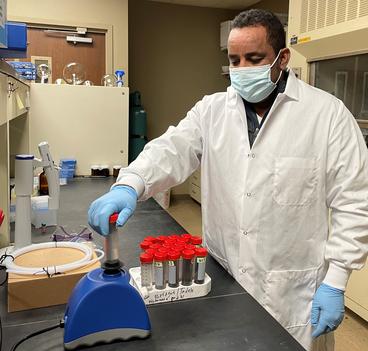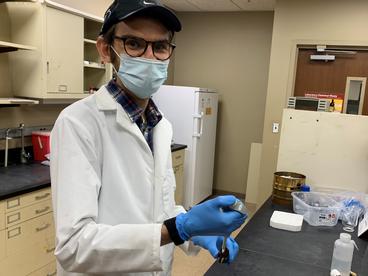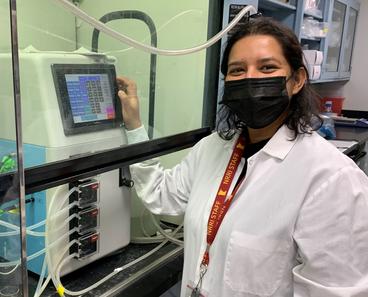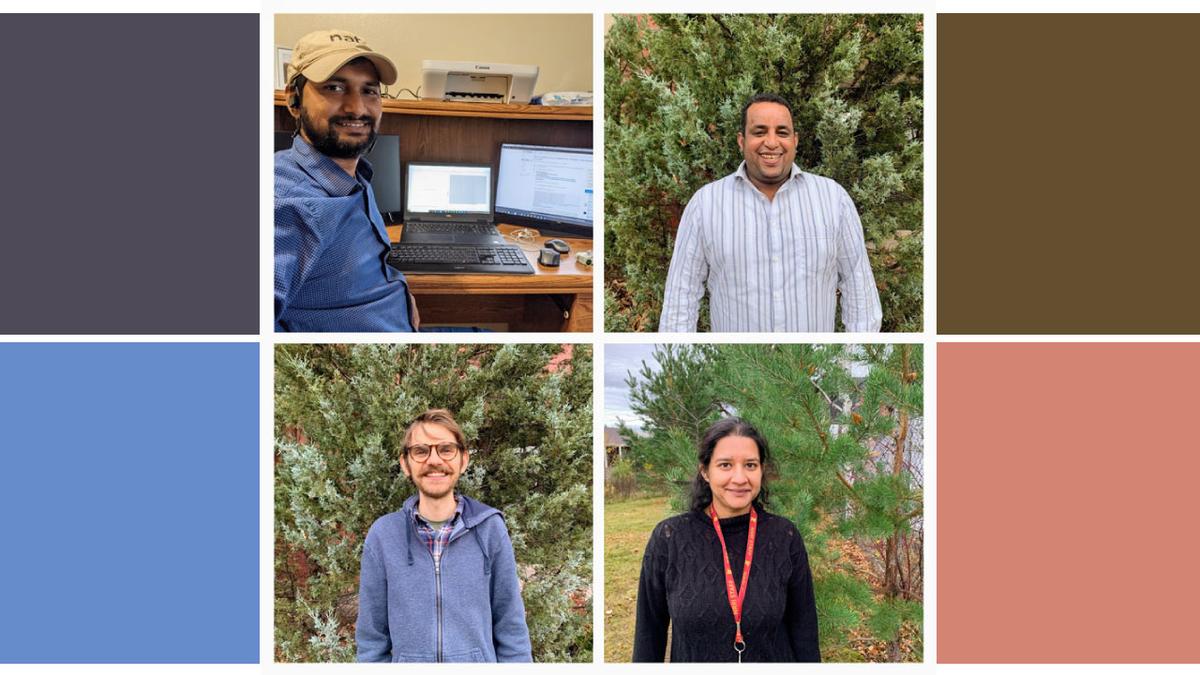Postdoc. It’s a common term in academia, and growing more common in industry, as well. But what exactly is a Postdoc?
It’s a person who finished their doctoral degree, a Ph.D, who is hired to an organization to gain skills and research experience on specific topics. NRRI currently has four Postdocs working on projects with real impact for Minnesota and beyond.
“Our NRRI Postdocs are a valuable part of our team,” said Rolf Weberg, NRRI executive director. “They bring fresh talent, perspective and enthusiasm that motivates the whole organization."
Meet Tadele
From Austria, to Duluth, Minnesota, Tadele Haile brings expertise in filter media for stormwater clean-up. Polluted stormwater runoff is an especially vexing challenge as climate change delivers more severe rain events.

During his Ph.D. studies at the University of Natural Resources and Life Science in Vienna, Haile was lead investigator and author of the Austrian Standard for the certification of commercially produced filter media. This experience is now being applied to NRRI’s biochar research and other materials applied to biofiltration systems for polluted stormwater. He is part of the team developing demonstration projects at the Mississippi Watershed Management Organization in the Twin Cities.
“We are developing a mobile stormwater testing laboratory that will collect data to inform watershed management and will also contribute to community education and outreach,” Haile explained.
Haile works across NRRI’s Water and Materials platforms to develop novel filtration media from waste natural resources, like beetle-killed trees and taconite industry byproducts.
He credits working at NRRI for broadening his expertise in evaluating biochar performance at lab-scale and its subsequent application for water treatment at the field scale.
“We produced 14 biochars from different feedstocks at varying pyrolysis temperatures, some exceeding 1,000 degrees Fahrenheit,” he said. “Having that capability at NRRI was really amazing and gave me a lot of opportunities to learn about biochar production and characterization.”
Meet Matthew
With a range of expertise, Matthew Berens is a valuable contributor to the new Great Lakes Sediment Surveillance Program. His skills in biogeochemistry, environmental engineering, soil chemistry and analytical chemistry all play well in the effort to identify legacy and emerging chemical contaminants in our valuable freshwater Great Lakes.

Berens received his Ph.D. in Civil Engineering from the University of Minnesota. His two-part thesis looked at the degradation of military munitions in soils and the risks associated with nicotine-like insecticides in Minnesota waterbodies.
“In just a few short months, our team of researchers worked quickly to adapt analytical methods that can measure over 200 contaminants in lake sediments,” said Berens. “Recording contaminant levels across the entire Great Lakes system will not only inform policy decisions and increase public awareness but also helps us understand the long-term impacts of pollutants in our shared water resources.”
Berens is also investigating the complicated relationship of mercury and sulfur in lakes and wetlands. Sulfate pollution (a form of sulfur) can lead to the formation of methylmercury, a dangerous neurotoxin that bioaccumulates in fish and is toxic to humans who eat the fish.
Berens enjoys his role in developing sustainable technologies for water treatment to ensure equitable access to clean water, both as sustenance and for recreation.
“Our goal is to develop a treatment system that can be deployed in the field to remove sulfate both before and after it enters a watershed,” he said. “In addition to the toxic effects of methylmercury, sulfate contamination is a concern for native manoomin (wild rice) populations, which is a sacred cultural and spiritual resource for the Anishinaabe nations of Minnesota.”
Meet Susma
While Duluth’s Spirit Mountain can’t compare to the soaring peaks of the Himalayan Mountains, the rocky natural beauty of the area still reminds Susma Bhattarai Gautam of her childhood home in Nepal.

But before she came to Duluth, Bhattarai Gautam tapped expertise across Europe to attain her doctoral degree from the IHE Delft Institute for Water Education in the Netherlands. Her Ph.D. work involved studying the unique microbial process of anaerobic oxidation of methane coupled with sulfate reduction in different bioreactor configurations. Her expertise in environmental engineering, microbiology and environmental chemistry are especially valuable to NRRI’s projects.
Bhattarai Gautam is involved in two NRRI projects to develop sustainable sulfate and nutrient removal from water and wastewater. For both systems, she is involved in the design, installation, operation and maintenance of the lab scale treatment system and pilot-scale biological sulfate treatment system for sulfate removal from the wastewater.
“The mobile pilot-scale treatment system applies our lab-based knowledge to a real field application, so I can see the practical implications of the system we developed,” said Bhattarai Gautam. “That’s a very exciting step for a researcher.”
Meet Saleh
In a unique shared position, Saleh Mamun is tackling a big question: What are the connections and interdependence between human economies and natural ecosystems?
Mamun is a natural resource economist specializing in ecosystem services. He came to Duluth in 2019 to fill a 50/50 position at NRRI and the University of Minnesota’s College of Food, Agricultural and Natural Resources Sciences, in the Applied Economics Department. He received his Ph.D. from the University of New Mexico while studying the interdependence of environmental and economic policy.
At NRRI, Mamun is working with a multidisciplinary team to develop a Forest Optimization Tool. Mamun’s role is to evaluate biophysical ecosystem services and convert them into monetary value, considering the trade-off among ecosystem services. He’s also analyzing the life cycle of forest harvest production.
“This will be a valuable tool for Minnesota forestry sector policymakers to decide best forest management practices,” said Mamun.
And on a much larger scale, Mamun is working on a global analysis that will provide national-scale indicators on the efficiency of natural and capital management to inform policy and strategic decisions. This Natural Capital Index is a collaboration between the University of Minnesota and Stanford University, funded by the World Bank Group.
“Natural Capital” is all the world's natural resources -- geology, soil, air and all the flora and fauna -- and the ecosystem services they provide that humans depend upon. The Natural Capital Index is a measure of the efficiency of sustainable use and management of natural capital in a country.
Pandemic Positions
Mamun was hired at NRRI in 2019 just before the Covid pandemic started, and Haile, Bhattarai Gautam and Berens were all hired during the pandemic lock-down. While the remote working and limited in-person contacts had its challenges, all four Postdocs can point to some highlights.
Many neighborhood walks and hikes in Duluth’s urban forests was a soothing tonic for them and Saleh used his extra time at home to learn to play guitar.
“I was really amazed by Duluth’s landscape and gorgeous view of the lake,” said Haile. “And the people here are friendly beyond my expectation.”
